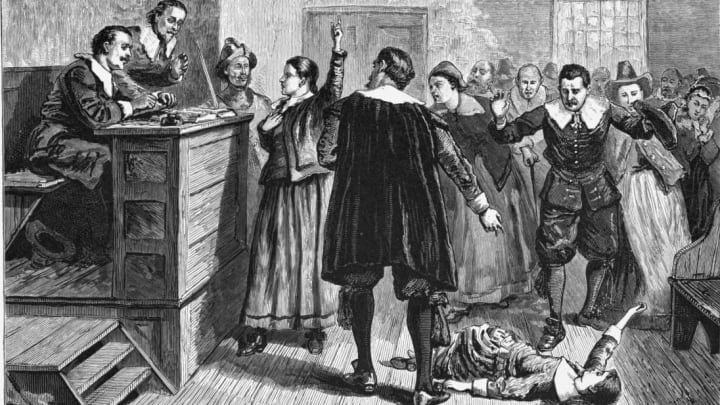On July 19, 1692, five women accused of witchcraft were publicly hanged from a tree on a rocky ledge in Salem, Massachusetts. The grisly event would mark the first of three mass executions held during the infamous Salem witch trials. Now, 325 years after that fateful day, Smithsonian reports that Salem mayor Kimberley Driscoll will dedicate a memorial at the site—called Proctor’s Ledge—to honor the 19 men and women hanged during the trials.
— Kev (Host @Vintage Burn Podcast) (@Kev_VintageBurn) July 13, 2017
The ceremony will take place on Wednesday, July 19, at noon, according to the Salem News. Speakers will include Driscoll, Salem State University history professor Emerson "Tad" Baker—who, along with a team of local researchers, recently identified the site of the hangings—and a descendant of Rebecca Nurse, an accused "witch" who lost her life on July 19, 1692.
Salem is already home to one memorial of the infamous prosecutions, dedicated in 1992 to mark the 300th anniversary of the trials. The new monument on Proctor’s Ledge is “a ledge wall that goes into the site with granite blocks,” city preservation planner Patricia Kelleher told the Salem News. "Within that retaining wall, there are blocks—19 blocks—and each block will have the name of the person and the date of the execution." These blocks will be illuminated at night, and a sidewalk along an adjacent residential street will allow visitors to pay their respects at the ledge.
The Salem witch trials are a major part of the New England city’s identity. But until 2016, the exact location of the hangings had been been lost to time. Local lore had it that the executions had been staged at the top of Gallows Hill, but no evidence existed to support that claim.
To solve the mystery, a team of local experts—including Baker—launched a research endeavor called the Gallows Hill Project. They examined eyewitness accounts of the hangings, read the writings of local historian Sidney Perley, and used aerial photography and ground-penetrating radar to locate the outcrop near the base of the hill, where many of Salem’s accused witches lost their lives. (Five additional individuals died in jail during the trials, and one was crushed to death with rocks.) Their findings were announced in early 2016.
During the 17th century, Proctor’s Ledge was public grazing land. In later centuries, it was named for Thorndike Proctor—a descendent of trial victim John Proctor, who became the main character in Arthur Miller's The Crucible—who purchased the surrounding land. Today, the wooded site is owned by the city, and sits between two residential streets and behind a Walgreens.
To respect nearby homeowners’ privacy, local officials advise visitors to continue paying their respects at the city's downtown monument to the Salem witch trials. However, they have acknowledged the importance of placing a marker on the execution site—even if they'd prefer it not become a new tourist attraction.
"I think knowing the exact location where the executions took place is important because we want to get history right," Driscoll said in a statement. "It's also an opportunity to come together and recognize the injustice and tragedy.”
[h/t Smithsonian]
